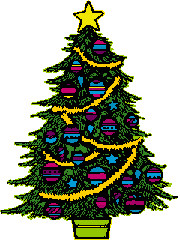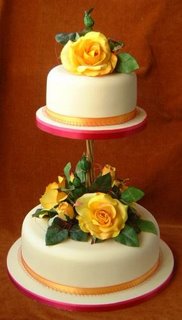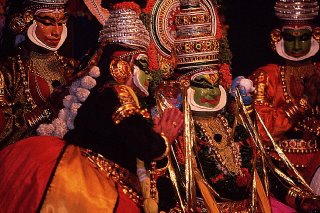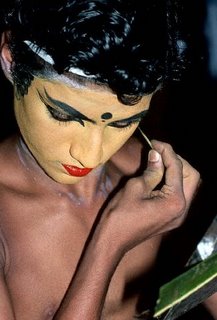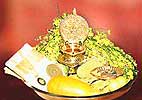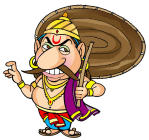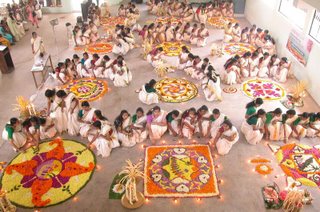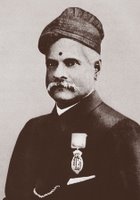 Raja Ravi Varma (1848-1906) was born in Kilimanoor Palace as the son of Umamba Thampuratti and Neelakandan Bhattathiripad. At the age of seven years he started drawing on the palace walls using charcoal. His uncle Raja Raja Varma noticed the talent of the child and gave preliminary lessons on painting. At the age of 14, Ayilyam Thirunal Maharaja took him to Travancore Palace and he was taught water painting by the palace painter Rama Swamy Naidu. After 3 years Theodor Jenson, a British painter taught him oil painting. He achieved recognition for his depiction of scenes from the epics of the Mahabharata and Ramayana. His paintings are considered to be among the best examples of the fusion of Indian traditions with the techniques of European academic art.
Raja Ravi Varma (1848-1906) was born in Kilimanoor Palace as the son of Umamba Thampuratti and Neelakandan Bhattathiripad. At the age of seven years he started drawing on the palace walls using charcoal. His uncle Raja Raja Varma noticed the talent of the child and gave preliminary lessons on painting. At the age of 14, Ayilyam Thirunal Maharaja took him to Travancore Palace and he was taught water painting by the palace painter Rama Swamy Naidu. After 3 years Theodor Jenson, a British painter taught him oil painting. He achieved recognition for his depiction of scenes from the epics of the Mahabharata and Ramayana. His paintings are considered to be among the best examples of the fusion of Indian traditions with the techniques of European academic art.Raja Ravi Varma is most remembered for his paintings of beautiful sari clad women, who were portrayed as very shapely and graceful. He stayed in the city of Bombay in Maharashtra for some years and drew many a beautiful Maharashtrian woman. His exposure in the west came when he won the first prize in Vienna Art Exhibition in 1873. After a successful career as a painter, Raja Ravi Varma died in (1906) at the age of 58. He is generally considered as one among the greatest painters in the history of Indian art.
Professional life
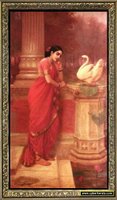 Raja Ravi Varma came to widespread acclaim after he won an award for an exhibition of his paintings at Vienna in 1873 (Citation required). He travelled throughout India in search of subjects. He often modeled Hindu Goddesses on South Indian women, whom he considered beautiful. Ravi Varma is particularly noted for his paintings depicting episodes from the story of Dushyanta and Shakuntala, and Nala and Damayanti, from the Mahabharata. Ravi Varma's representation of mythological characters has become a part of the Indian imagination of the epics. He is often criticized for being too showy and sentimental in his style. However his work remains very popular in India.
Raja Ravi Varma came to widespread acclaim after he won an award for an exhibition of his paintings at Vienna in 1873 (Citation required). He travelled throughout India in search of subjects. He often modeled Hindu Goddesses on South Indian women, whom he considered beautiful. Ravi Varma is particularly noted for his paintings depicting episodes from the story of Dushyanta and Shakuntala, and Nala and Damayanti, from the Mahabharata. Ravi Varma's representation of mythological characters has become a part of the Indian imagination of the epics. He is often criticized for being too showy and sentimental in his style. However his work remains very popular in India.Prominent works
The following is a list of the prominent works of Ravi Varma.
X Village Belle
X Lady Lost in Thought
X Damayanti Talking to a Swan
X The Orchestra
X Arjuna and Subhadra
X Lady with Fruit
X The Heartbroken
X Swarbat Player
X Shakuntala
X Lord Krishna as Ambassador
X Jatayu, a bird devotee of Lord Rama is mauled by Rawana
X Victory of Meghanada
X A Family of Beggars
X A Lady Playing Swarbat
X Lady Giving Alms at the Temple
X Lord Rama Conquers Varuna
X Romancing Couple
X Draupadi Dreading to Meet Kichaka
X Shantanu and Matsyagandha
X Shakuntala Composing a Love Letter to King Dushyanta
X Girl in Sage Kanwa's Hermitage (Rishi-Kanya)
Philosophical outlook
Raja Ravi Varma's philosophical outlook is not known or documented, especially his understanding of Western Art forms, though it should be acknowledged that he received formal and systematic training. Those who seek to critically examine his contribution are severely impaired in their project by the absence of any literature written by him (one would require an interpretation of the diary maintained by his brother - also his co-worker and assistant.)
Criticism of Raja Ravi Varma
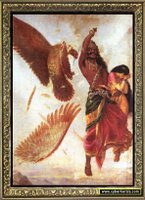 Raja Ravi Varma is often criticised for the fact that his paintings overshadowed traditional Indian art forms because of their widespread reproduction as oleographs, flooding Indian culture with his version of Indian myths, portrayed with a rather static realism. According to Dasgupta, by dispensing with stylisation in favour of stiff academicism, Ravi Varma can be considered as having in one stroke undermined traditional Indian art, which was both dynamic and rich in form and content. One can find an illustration of this argument in the figures of Durga in West Bengal or in the folk form of Madhubani Paintings. In comparison, Ravi Varma's approach clearly lacks this dynamism of expression. Moreover, his approach of frontality has severe limitations in terms of space and movement. By rejecting the traditional models of representation (for example, the Chitrasutra, the treatise on art outlined in Vishnudharmottara Purana), he has reduced mythic heroes to the level of ordinary humans, a form that has been copied in many depictions of mythic history in other media such as cinema and television. Dadasaheb Phalke, considered the father of Indian cinema, is thought to have been influenced by Ravi Varma's static realism.
Raja Ravi Varma is often criticised for the fact that his paintings overshadowed traditional Indian art forms because of their widespread reproduction as oleographs, flooding Indian culture with his version of Indian myths, portrayed with a rather static realism. According to Dasgupta, by dispensing with stylisation in favour of stiff academicism, Ravi Varma can be considered as having in one stroke undermined traditional Indian art, which was both dynamic and rich in form and content. One can find an illustration of this argument in the figures of Durga in West Bengal or in the folk form of Madhubani Paintings. In comparison, Ravi Varma's approach clearly lacks this dynamism of expression. Moreover, his approach of frontality has severe limitations in terms of space and movement. By rejecting the traditional models of representation (for example, the Chitrasutra, the treatise on art outlined in Vishnudharmottara Purana), he has reduced mythic heroes to the level of ordinary humans, a form that has been copied in many depictions of mythic history in other media such as cinema and television. Dadasaheb Phalke, considered the father of Indian cinema, is thought to have been influenced by Ravi Varma's static realism.

